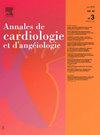阿比让(Cote d '科特迪瓦)心脏研究所心脏病科房颤管理的回顾性分析
IF 0.3
Q4 Medicine
引用次数: 0
摘要
目的分析撒哈拉以南非洲地区某心内科房颤的管理情况。方法和结果我们在阿比让心脏病研究所(Côte d'Ivoire)的心内科对146例连续住院的18岁以上的房颤患者进行了回顾性研究。研究人群的平均年龄为61.2±15.5岁,以女性为主(51.4%)。阵发性、持续性和永久性纤颤的患病率分别为11.6%、4.1%和32.2%。105例患者的基础病理为:高血压心脏病(47.2%)、瓣膜性心脏病(15.7%)和扩张性心肌病(4.1%)。大多数病例(84.2%)选择心率控制策略。-受体阻滞剂(36.3%)、地高辛(20.5%)和胺碘酮(18%)是最常用的药物类别。平均CHA2DS2VASc评分为3±1.57,85.2%的患者CHA2DS2VASc评分≥2。需要口服抗凝治疗的患者中,91例(76.5%)接受了口服抗凝治疗。结论心房颤动在我国是严重的,因为心衰、高血压心脏病和心血管危险因素的患病率更高,所有这些因素都增加了血栓栓塞的风险。尽管CHA2DS2VASc评分较高,但仍有76.5%的患者采用心率控制策略,并正确使用口服抗凝药物。本文章由计算机程序翻译,如有差异,请以英文原文为准。
Analyse rétrospective de la prise en charge de la fibrillation atriale dans un service de cardiologie à l’Institut de Cardiologie d’Abidjan (Côte d’Ivoire)
Objective
The aim of this study was to analyze the management of atrial fibrillation in a cardiology department in sub-Saharan Africa.
Methodology and results
We conducted a retrospective study of 146 consecutive patients aged at least 18 years hospitalized for atrial fibrillation over a two-year period in our cardiology department at the cardiology institute of Abidjan (Côte d'Ivoire). The mean age of the study population was 61.2 ±15.5 years, and the majority were women (51.4%). The respective prevalences of paroxysmal, persistent, and permanent fibrillation were 11.6%, 4.1%, and 32.2%.
The underlying pathologies found in 105 patients were: hypertensive heart disease (47.2%), valvular heart disease (15.7%), and dilated cardiomyopathy (4.1%). A heart rate control strategy was chosen in the majority of cases (84.2%). Beta-blockers (36.3%), digoxin (20.5%), and amiodarone (18%) were the most commonly used drug classes. The mean CHA2DS2VASc score was 3±1.57, and 85.2% of patients had a CHA2DS2VASc score ≥ 2. Of the patients requiring oral anticoagulation, 91 (76.5%) received it.
Conclusion
Atrial fibrillation is severe in our context because of the greater prevalence of heart failure, hypertensive heart disease and cardiovascular risk factors, all of which increase the risk of thromboembolism. The heart rate control strategy was predominant and oral anticoagulation was correctly prescribed in 76.5% despite a high CHA2DS2VASc score.
求助全文
通过发布文献求助,成功后即可免费获取论文全文。
去求助
来源期刊
CiteScore
0.60
自引率
0.00%
发文量
68
审稿时长
6-12 weeks
期刊介绍:
Organe scientifique de référence fondé en 1951, les Annales de cardiologie et d''angéiologie abordent tous les domaines qui intéressent quotidiennement les cardiologues et les angéiologues praticiens : neurologie et radiologie vasculaires, hémostase, diabétologie, médecine interne, épidémiologie et prévention.
Les Annales de cardiologie et d''angéiologie sont indexées aux grandes bases de données et publient rapidement, et en conformité avec les normes internationales de publication scientifique, des articles en français sur la pathologie cardiaque.

 求助内容:
求助内容: 应助结果提醒方式:
应助结果提醒方式:


